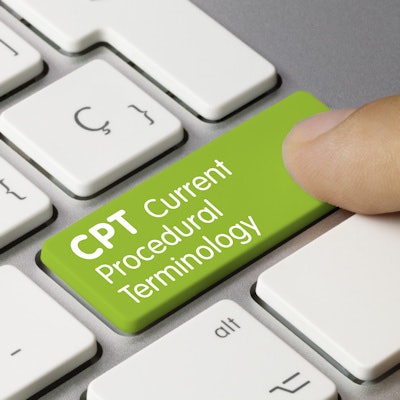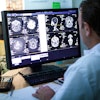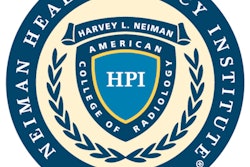
For diagnostic radiology, the changes to the Current Procedural Terminology (CPT) codes for 2020 are relatively few, and they are concentrated in the areas of abdominal and gastrointestinal plain radiographs, nuclear medicine procedures for tumor localization, and myocardial PET imaging. The changes to interventional radiology coding are likewise quite limited and involve pericardial and spinal puncture procedures.
Diagnostic radiology
Abdominal and gastrointestinal imaging
These exams now include all scout radiographs and delayed images in the basic procedure code, and distinction is made between single- and double-contrast studies.
- Complete acute abdomen series (74022): The code now specifies that two or more views of the abdomen must be included -- for example, supine, erect, and/or decubitus.
- Pharynx and/or cervical esophagus (74210): The code now specifies that this is a barium contrast exam that includes scout neck radiographs and delayed images.
- Esophagus: The codes now include scout chest radiographs and delayed images.
- Use 74220 (revised) for a single-contrast exam.
- Use 74221 (new) for a double-contrast exam (e.g., high-density barium and an effervescent agent).
- Swallowing function (74230): The code now specifies that this is a barium contrast exam that includes scout neck radiographs and delayed images.
- Upper gastrointestinal tract: The codes now include scout abdominal radiographs and delayed images.
- Use 74240 (revised) for a single-contrast exam.
- Use 74246 (revised) for a double-contrast exam (e.g., high-density barium and an effervescent agent) including glucagon when administered.
- Add 74248 (new) to either of these codes to report small intestine follow-through studies.
- The following have been deleted:
- 74241 replaced by 74240
- 74245 replaced by 74240 + 74248
- 74247 replaced by 74246
- 74249 replaced by 74246 + 74248
- Small intestine: The codes now include multiple serial images and scout abdominal radiographs and delayed images. Existing codes have been revised:
- Use 74250 for single-contrast exam.
- Use 74251 for a double-contrast exam (e.g., high-density barium and air via enteroclysis tube).
- For duodenogram, 74260 has been deleted and replaced by 74251.
- Colon: The codes now include scout abdominal radiographs and delayed images. Existing codes have been revised:
- Use 74270 for a single-contrast exam.
- Use 74280 for a double-contrast exam (e.g., high-density barium and air) including glucagon when administered.
Nuclear medicine
New codes were added to report tumor localization using SPECT and SPECT/CT.
| New codes for tumor localization using SPECT and SPECT/CT | |
| CPT code | Description |
| 78830 (new) | SPECT with concurrent CT for anatomical review, localization, and determination/detection of pathology Single area (e.g., head, neck, chest, pelvis) Single-day imaging |
| 78831 (new) | SPECT only for anatomical review, localization, and determination/detection of pathology Minimum 2 areas (e.g., pelvis and knees, abdomen and pelvis) Single-day imaging, or Single-area imaging over two or more days |
| 78832 (new) | SPECT with concurrent CT for anatomical review, localization, and determination/detection of pathology Minimum of two areas (e.g., pelvis and knees, abdomen and pelvis) Single-day imaging, or |
| 78835 (new add-on) | Radiopharmaceutical quantification measurements Single area Use with 78830 or 78832 Report multiple units for more than one area or more than one day of imaging |
These scans were previously reported using 78805, 78806, and 78807.
The following codes have all been deleted and will now be reported using the tumor localization code 78803 (SPECT, single area, single-day imaging):
- CPT 78205 and 78206 liver imaging (SPECT)
- CPT 78320 bone and joint imaging (SPECT)
- CPT 78607 brain imaging (SPECT)
- CPT 78647 cerebrospinal fluid flow imaging (cisternography) (SPECT)
- CPT 78710 kidney imaging (SPECT)
The reporting of myocardial PET imaging has been enhanced with the addition of six new codes. Here is a complete rundown of the relevant code sequences:
| New and revised codes for myocardial PET | |
| CPT code | Description |
| 78459 (revised) | Metabolic evaluation study (including ventricular wall motion and/or ejection fractions, when performed) Single study |
| 78429 (new) | With concurrent CT imaging |
| 78491 (revised) | Perfusion study (including ventricular wall motion and/or ejection fractions, when performed) Single study, at rest or stress (either exercise or pharmacologic) |
| 78430 (new) | Single study, at rest or stress (either exercise or pharmacologic) With concurrent CT imaging |
| 78492 (revised) | Multiple studies at rest and stress (either exercise or pharmacologic) |
| 78431 (new) | Multiple studies at rest and stress (either exercise or pharmacologic) With concurrent CT imaging |
| 78432 (new) | Combined perfusion with metabolic evaluation study (including ventricular wall motion and/or ejection fractions, when performed) Dual radiotracer (e.g., myocardial viability) |
| 78433 (new) | With concurrent CT imaging |
| 78434 (new add-on) | Absolute quantitation of myocardial blood flow (AQMBF) Rest and pharmacologic stress Use with 78431 or 78492 |
Other diagnostic radiology
There are two new codes for arterial inflow and venous outflow for preoperative vessel assessment prior to the creation of hemodialysis access using duplex Doppler ultrasound. These codes replace the HCPCS1 code G0365.
- CPT 93985 for complete bilateral study
- CPT 93986 for complete unilateral study
Category III HCPCS codes in the range of 0554T to 0557T have been created for bone strength and fracture risk assessment using CT; however, these are not yet covered services for Medicare reimbursement.
Interventional radiology
The reporting of pericardiocentesis and pericardial drainage has been enhanced by the addition of four new codes that expand upon three deleted codes. The new codes include all imaging guidance, when performed.
| New codes for pericardiocentesis and pericardial drainage | |
| CPT code | Description |
| 33016 (new) | Pericardiocentesis, including imaging guidance Replaces 33010 and 33011 |
| 33017 (new) | Pericardial drainage with insertion of indwelling catheter, percutaneous Including fluoroscopy and/or ultrasound guidance Age 6 and older without congenital cardiac anomaly |
| 33018 (new) | Including fluoroscopy and/or ultrasound guidance Up to 5 years of age or any age with congenital cardiac anomaly |
| 33019 (new) | Including CT guidance |
Tube pericardiostomy is now reported using 33017, 33018, or 33019 rather than the deleted code 33015.
Lumbar puncture procedure reporting has been expanded by the addition of two new codes that incorporate fluoroscopic or CT imaging guidance.
| New and revised codes for lumbar puncture procedure | |
| CPT code | Description |
| 62270 (revised) | Spinal puncture, lumbar, diagnostic |
| 62328 (new) | With fluoroscopic or CT guidance |
| 62272 (revised) | Spinal puncture, therapeutic, for drainage of cerebrospinal fluid (by needle or catheter) |
| 62329 (new) | With fluoroscopic or CT guidance |
If MRI guidance is used, then 77021 may be added to 62270 and 62272. If ultrasound guidance is used, then 76942 may be added.
Conclusion
As compared with other years, coding changes for 2020 are relatively few. Although Medicare has reported that the overall effect of revisions to the 2020 Medicare Physician Fee Schedule on radiology practices will be minimal, we will separately analyze the financial impact of these and other valuation changes in an upcoming article. Each practice has to evaluate any fee schedule changes in light of its mix of modalities and procedure volume.
1Healthcare Common Procedure Coding System (HCPCS) level II codes and descriptors are approved and maintained jointly by the alpha-numeric editorial panel (consisting of the U.S. Centers for Medicare and Medicaid Services, America's Health Insurance Plans, and the Blue Cross and Blue Shield Association).
Erin Stephens serves as the senior client manager, education for Healthcare Administrative Partners.
The comments and observations expressed are those of the author and do not necessarily reflect the opinions of AuntMinnie.com.



















